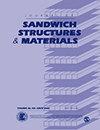面板厚度对碳/环氧/Nomex蜂窝夹芯板抗弯强度特性的影响
IF 2.8
3区 材料科学
Q1 ENGINEERING, MECHANICAL
引用次数: 0
摘要
本研究介绍了一项关于改变Nomex蜂窝夹层板的碳/环氧面板厚度对其弯曲性能影响的调查结果。面板的厚度(hs)通过增加层数来改变,从0.25 mm厚的一层增加到8层,总标称厚度为2.0 mm,同时保持芯厚不变。通过一系列三点和四点弯曲试验,研究了夹芯板的抗弯性能。一个特别的重点是识别随着面板厚度的增加而发生的失效模式的变化。采用夹芯梁理论对夹芯板的抗弯性能进行了预测,与实验值的偏差小于13%。使用方差分析(ANOVA)工具,采用双参数威布尔分布模型预测最大弯曲载荷,并观察到与实验值具有良好的相关性。在所有情况下,预测的最大负荷值与实验结果的差异都在5%以下。在最厚的面板中观察到脆性破坏模式。在强度和刚度方面,基于1.5 mm厚面板的夹层板被认为是最合适的设计。本文章由计算机程序翻译,如有差异,请以英文原文为准。
Influence of face sheet thickness on flexural strength characteristics of carbon/epoxy/Nomex honeycomb sandwich panels
This study presents the findings of an investigation into the effect of varying the thickness of a carbon/epoxy face sheet of a Nomex honeycomb sandwich panel on its the flexural properties. The thickness (hs) of the face sheet was varied by increasing the number of plies from one 0.25 mm thick layer to eight such layers, giving a total nominal thickness of 2.0 mm, whilst maintaining a constant thickness of the core. The flexural properties of the sandwich panels were investigated through a series of three- and four-point bending tests. A particular focus was on identifying changes in the failure mode with increasing face sheet thickness. The flexural properties of the sandwich panels were predicted using sandwich beam theory, where the deviation from the experimental values was shown to be less than 13%. A two parameter Weibull distribution model was used to predict the maximum flexural load using an analysis of variance (ANOVA) tool and an excellent level of correlation was observed with the experimental values. The difference between the predicted maximum load values and the experimental results was below 5% in all cases. A brittle mode of failure was observed in the thickest panel. The sandwich panel based on 1.5 mm thick face sheet was identified as being the most appropriate design, both in terms of strength and stiffness.
求助全文
通过发布文献求助,成功后即可免费获取论文全文。
去求助
来源期刊

Journal of Sandwich Structures & Materials
工程技术-材料科学:表征与测试
CiteScore
9.60
自引率
2.60%
发文量
49
审稿时长
7 months
期刊介绍:
The Journal of Sandwich Structures and Materials is an international peer reviewed journal that provides a means of communication to fellow engineers and scientists by providing an archival record of developments in the science, technology, and professional practices of sandwich construction throughout the world. This journal is a member of the Committee on Publication Ethics (COPE).
 求助内容:
求助内容: 应助结果提醒方式:
应助结果提醒方式:


